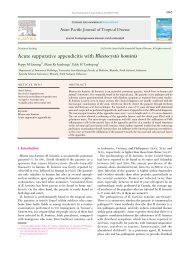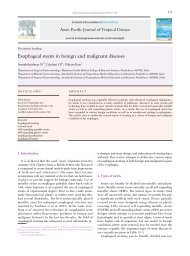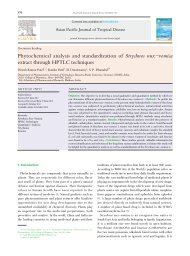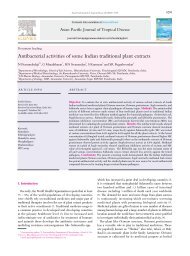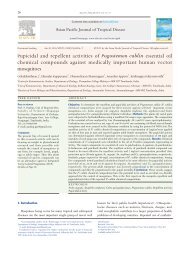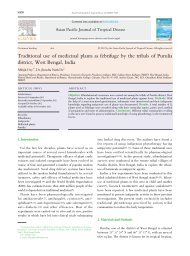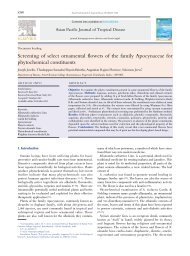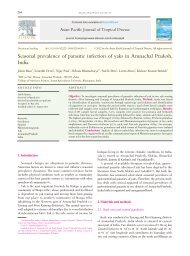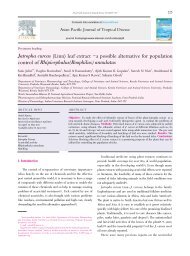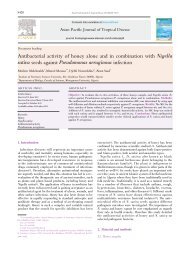Larvicidal activity of Phyllanthus emblica Linn ... - Apjtcm.com
Larvicidal activity of Phyllanthus emblica Linn ... - Apjtcm.com
Larvicidal activity of Phyllanthus emblica Linn ... - Apjtcm.com
You also want an ePaper? Increase the reach of your titles
YUMPU automatically turns print PDFs into web optimized ePapers that Google loves.
400<br />
hepatoprotective, gastroprotective, and chemopreventive<br />
properties [10]. The leaf extracts <strong>of</strong> this plant exhibited<br />
adulticidal and larvicidal properties against the adult cattle<br />
tick Haemaphysalis bispinosa Neumann, 1897 (Acarina:<br />
Ixodidae), sheep fluke Paramphistomum cervi Zeder, 1790<br />
(Digenea: Paramphistomatidae), fourth instar larvae <strong>of</strong><br />
malaria vector, Anopheles subpictus Grassi and Japanese<br />
encephalitis vector, Culex tritaeniorhynchus Giles (Diptera:<br />
Culicidae) [11]. Therefore the present study was carried<br />
out to determine the larvicidal <strong>activity</strong> <strong>of</strong> P. <strong>emblica</strong> leaf<br />
extracts against important vectors Aedes aegypti and Culex<br />
quinquefasciatus.<br />
2. Materials and methods<br />
2.1 Plant collection and extraction<br />
P. <strong>emblica</strong> leaves collected in and around Tiruchirapalli<br />
district, Tamil Nadu, India were brought to the laboratory<br />
at PG and Research Depaerment <strong>of</strong> Zoology, Arignar Anna<br />
Government Arts College, Musiri, Tiruchirapalli, Tamil<br />
Nadu, India.; shade dried under room temperature and<br />
powdered using an electric blender. A total <strong>of</strong> 1 kg <strong>of</strong> dried<br />
and powdered leaves was subjected to sequential extraction<br />
using 3 L <strong>of</strong> hexane, diethyl ether and ethyl acetate for<br />
a period <strong>of</strong> 72 h to obtain the crude extracts using rotary<br />
vacuum evaporator. The hexane, diethyl ether, and ethyl<br />
acetate crude extracts thus obtained were lyophilized<br />
and a stock solution <strong>of</strong> 100 000 ppm prepared from each<br />
crude extract by adding adequate volume <strong>of</strong> acetone was<br />
refrigerated at 4 °C until testing for bioassays.<br />
2.2. Test organisms<br />
All tests were carried out against laboratory reared vector<br />
mosquitoes viz., Aedes aegypti (Ae. aegypti) and Culex<br />
quinquefasciatus (Cx. quinquefasciatus) free <strong>of</strong> exposure to<br />
insecticides and pathogens. Cyclic generations <strong>of</strong> vector<br />
mosquitoes were maintained at 25-29 °C and 80-90 %<br />
relative humidity in the insectarium. Larvae were fed on<br />
larval food (powdered dog biscuit and yeast in the ratio <strong>of</strong> 3:1)<br />
and adult mosquitoes on 10 % glucose solution. Adult female<br />
mosquitoes were periodically blood-fed on restrained albino<br />
mice for egg production.<br />
2.3. <strong>Larvicidal</strong> <strong>activity</strong><br />
Standard WHO protocol with slight modifications<br />
was adopted for the study [12]. From the stock solution,<br />
concentrations <strong>of</strong> 50, 100, 150, 200 and 250 ppm were<br />
prepared. Twenty five early third instar larvae were<br />
introduced in 250 mL beaker containing 200 mL <strong>of</strong> water with<br />
each concentration. A control was prepared by the addition<br />
<strong>of</strong> acetone to water. Mortality was recorded after 72 hours.<br />
Alagarmalai JEYASANKAR et al./Asian Pacific Journal <strong>of</strong> Tropical Disease (2012)S399-S403<br />
A total <strong>of</strong> three trials were carried out with five replicates<br />
per trial against vector mosquitoes. However, when the<br />
control mortality ranged from 5-20 per cent, the observed<br />
percentage mortality was corrected by Abbott’s formula [13],<br />
2.4. Statistical analysis<br />
SPSS 11.5 version package was used for determination<br />
<strong>of</strong> LC 50 and LC 90 [14]. Data from mortality and effect <strong>of</strong><br />
concentrations were subjected to analysis <strong>of</strong> variance.<br />
The percentage data obtained was angular transformed.<br />
Difference between the treatments was determined by<br />
Tukey’s test (P < 0.05).<br />
3. Results<br />
Larval toxicity <strong>of</strong> leaf extracts <strong>of</strong> P. <strong>emblica</strong> against Ae.<br />
aegypti, and Cx. quinquefasciatus reported in the present<br />
study exhibit the mosquitocidal properties in the plant<br />
leaf extracts suggesting their use in mosquito population<br />
control (Tables 1- 3). The different solvent crude extracts <strong>of</strong><br />
P. <strong>emblica</strong> showed promising larval mortality against two<br />
important mosquito vectors. According to the data, larvae<br />
<strong>of</strong> Cx. quinquefasciatus were more susceptible than Ae.<br />
Aegypti. The data pertaining to the hexane extract <strong>of</strong> P.<br />
<strong>emblica</strong> against the fourth instar larvae <strong>of</strong> A. aegypti and C.<br />
quinquefasciatus are shown in table 1. The larval mortality <strong>of</strong><br />
the A. aegypti was more prominent than C. quinquefasciatus<br />
as evidenced from the table 1, which showed 86.0% mortality<br />
in A. aegypti whereas, 73.6% larval mortality was recorded in<br />
C.quinquefasciatus at 250ppm concentration with the LC50<br />
<strong>of</strong> 111.34 (LCL=93.07 - UCL=133.20) and LC 50 <strong>of</strong> 136.78ppm<br />
(LCL=113.21 - UCL=165.25) respectively. Similar trend <strong>of</strong><br />
larval toxicity was also observed in diethyl ether extract <strong>of</strong><br />
P. <strong>emblica</strong> against the selected two vector mosquito species<br />
(Table 2). Besides, the ethyl acetate extract <strong>of</strong> P. <strong>emblica</strong><br />
exhibited the maximum larvicidal <strong>activity</strong> (99.6%) with LC50<br />
value <strong>of</strong> 78.89 ppm against the larvae <strong>of</strong> Ae. aegypti. The<br />
screening <strong>of</strong> local medicinal plants for mosquito larvicidal<br />
<strong>activity</strong> may eventually lead to their use in natural productbased<br />
mosquito abatement practices.<br />
4. Discussion<br />
The results <strong>of</strong> present study are <strong>com</strong>parable with similar<br />
reports <strong>of</strong> earlier workers. Bhagan et al [11] who have<br />
been reported that ethyl acetate and methanol extracts<br />
<strong>of</strong> P. <strong>emblica</strong> showed highest larval mortality against C.<br />
tritaeniorhynchus with LC 50 = 54.82 ppm; LC 90 199.89 ppm,<br />
respectively and adult mortality was found in leaf methanol<br />
extracts against H. bispinosa and P. cervi with LC 50 = 256.08;<br />
60.60 ppm; LC 90 = 1025.60; 287.48 ppm respectively. Sharma<br />
et al [15] reported that, petroleum ether extract <strong>of</strong> Ageratum



